Building a great back is no small feat.
The back comprises myriad muscles, many of which take their sweet time to grow.
It’s no wonder so many people are interested in finding the best back exercises.
However, learning which back exercises are worthwhile is tricky. With a plethora of movements labeled as “the best,” it’s easy to get lost in the shuffle.
Here’s what you need to know: the real best back exercises allow you to lift heavy weights safely, progress regularly, and train several back muscles simultaneously.
Below are 25 of the best back exercises for the gym and home that meet these criteria. Add these to your back workouts, and you’ll have a stronger, more muscular back in no time.
Want to know exactly how you should train to reach your fitness goals? Take our free 60-second training quiz and find out now.
Back Muscle Anatomy
The main muscles that make up the bulk of the back are:
- Trapezius (traps)
- Rhomboids
- Latissimus dorsi (lats)
- Erector spinae (iliocostalis, longissimus, and spinalis muscles)
- Teres major and minor
- Infraspinatus
Here’s how they look:
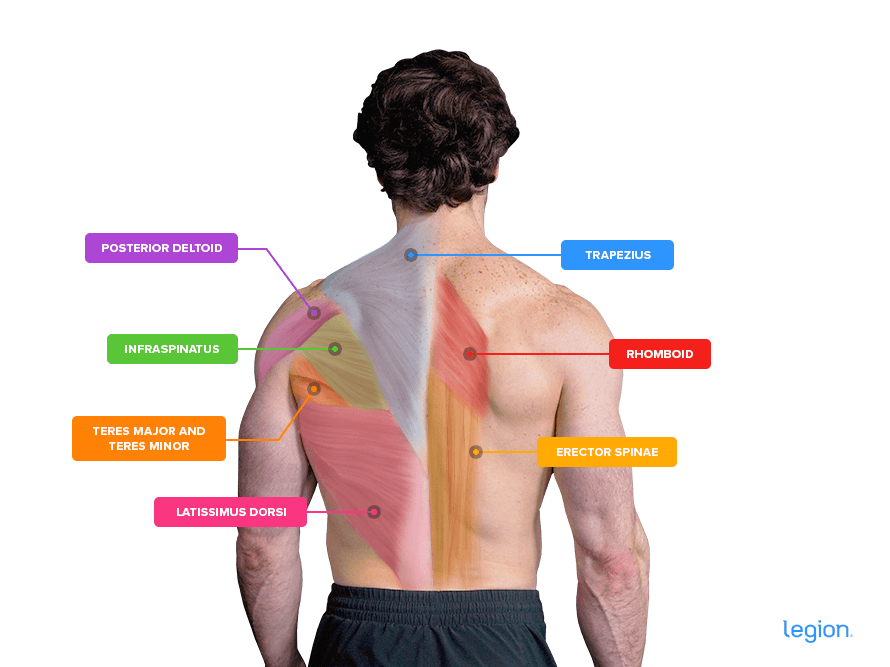
The 25 Best Back Exercises for Your Entire Back
The back exercises below are the best back exercises for gym-goers who want well-developed traps, thick spinal erectors, wide lats, and clearly defined rhomboids, infraspinati, and teres muscles.
1. Deadlift
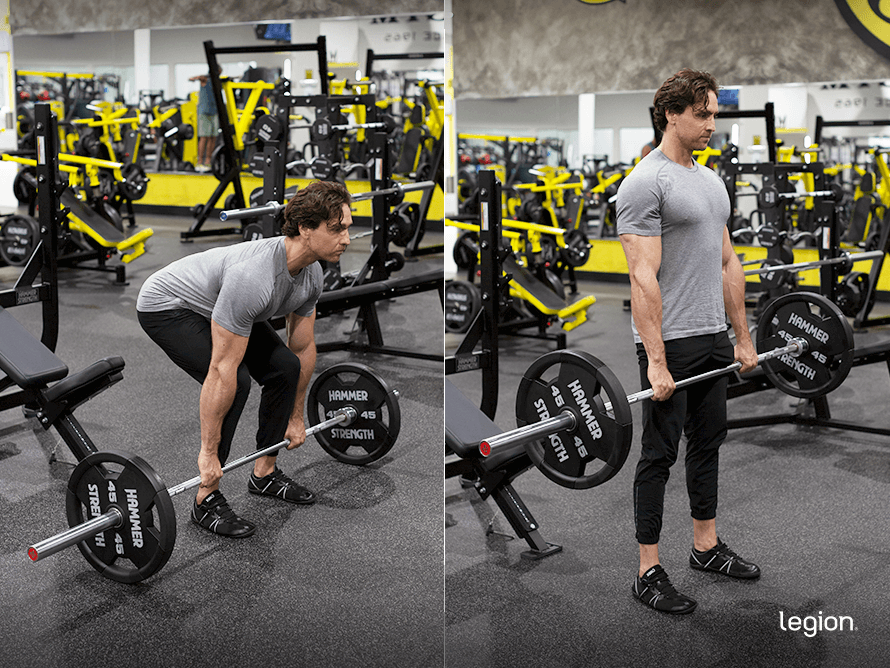
Why: The deadlift is the best all-around back exercise because it trains every muscle on the back of your body. As a bonus, it also trains your quads, abs, shoulders, and grip strength. Its main advantage is that it allows you to lift heavy weights safely and progress regularly, which is vital for muscle and strength gain.
How to: Position your feet so they’re a little narrower than shoulder-width apart with your toes pointed slightly out, then move a loaded barbell over your midfoot. Move toward the bar by pushing your hips back, then grab the bar just outside your shins. Drive your body upward and slightly back by pushing through your heels. As you approach the lockout, push your hips into the bar, then reverse the movement and return to the starting position.
Sets and Reps: 3 sets of 4-to-6 reps with 2-to-5 min rest
2. Trap-Bar Deadlift
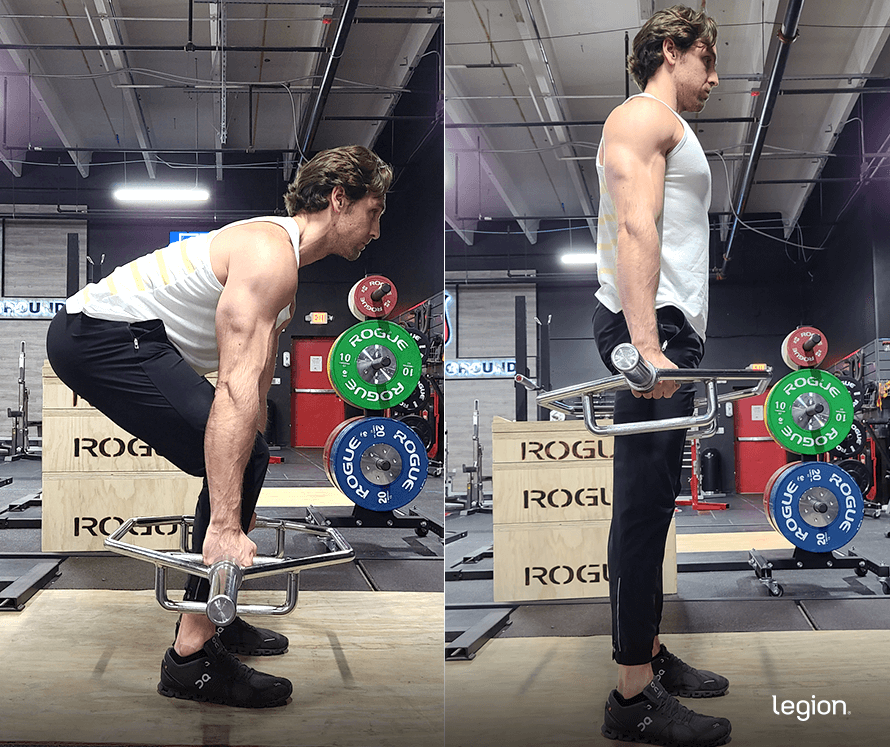
Why: For many people, the trap-bar deadlift is more comfortable and easier to learn than the conventional deadlift. It also allows you to lift around 5-to-10% more weight than you can with the barbell deadlift, and it may be slightly better for improving athletic performance.
How to: Position your feet about shoulder-width apart inside the rectangular center of the trap bar, and adjust your foot position so that when you tug on the bar, it moves straight up, not backward or forward. Hinge at the hips, arch your lower back slightly, and keep your shoulders back and down. Drive your body upward and slightly back by pushing through your heels. As the bar passes your knees, push your hips forward. Reverse the movement and return to the starting position.
Sets and Reps: 3 sets of 4-to-6 reps with 2-to-5 min rest
3. Sumo Deadlift
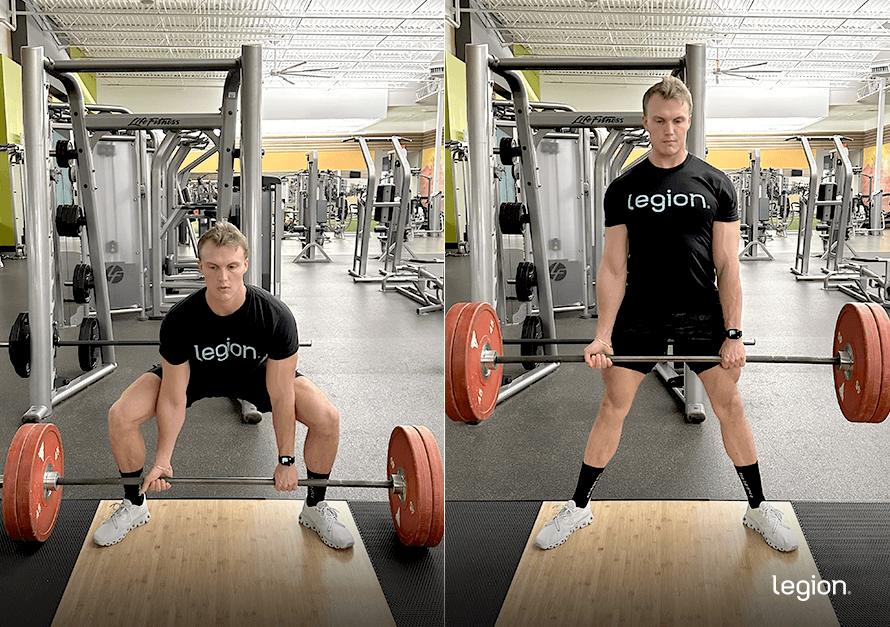
Why: The sumo deadlift is a good back exercise if you experience pain or discomfort during the conventional barbell deadlift because it uses a slightly shorter range of motion and allows you to maintain a more vertical back angle, reducing stress on the spine.
How to: Position your feet outside of shoulder-width apart and point your toes slightly outward, then move a loaded barbell over your midfoot. Drop your butt, letting your knees bend slightly while staying in line with your feet and keeping your back straight. Your shins should be vertical, and you should be able to grip the bar comfortably. Stand up while pulling the bar up your shins, then reverse the movement and return to the starting position.
Sets and Reps: 3 sets of 4-to-6 reps with 2-to-5 min rest
4. Romanian Deadlift
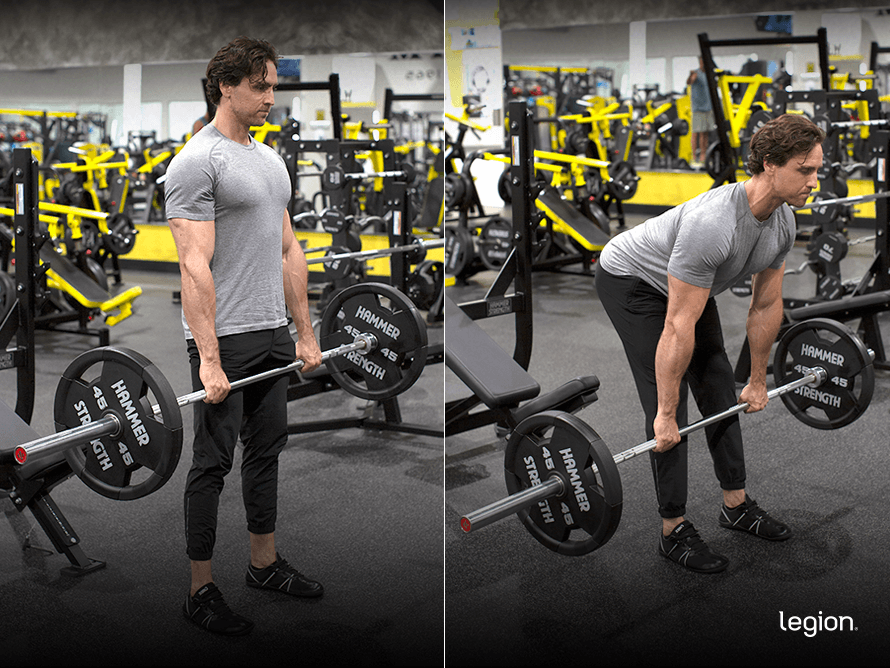
Why: The Romanian deadlift (RDL) trains the posterior chain similarly to the conventional deadlift. However, it’s less fatiguing than the conventional deadlift, allowing you to do it more frequently without wearing yourself to a frazzle.
How to: Stand up straight holding a loaded barbell with a shoulder-width, overhand grip (palms facing toward your body). Flatten your back and lower the weights toward the floor in a straight line while keeping your legs mostly straight, allowing your butt to move backward as you descend. Once you feel a stretch in your hamstrings, bend your knees slightly more and continue lowering the weights until your lower back begins to round—just below the knees for most people and about mid-shin for those who are particularly flexible. Reverse the movement and return to the starting position.
Sets and Reps: 3 sets of 4-to-6 reps with 2-to-3 min rest
5. Dumbbell Deadlift
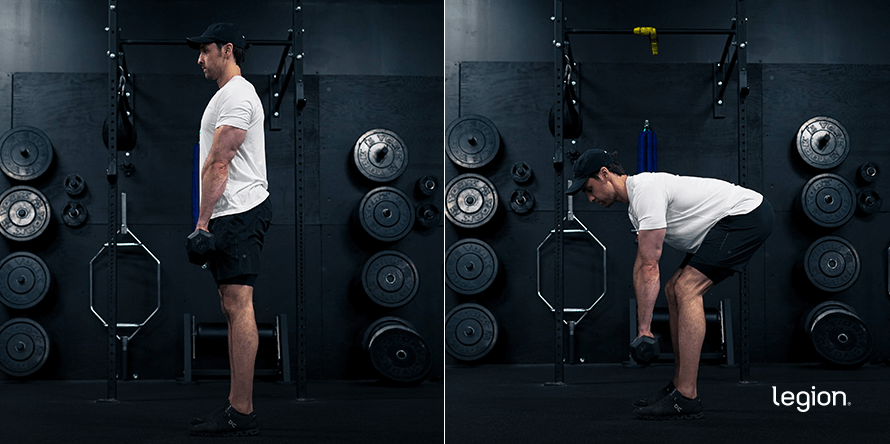
Why: The dumbbell deadlift is the same as the conventional barbell deadlift, only you use a pair of dumbbells instead of a barbell. This means you can still get most of the benefits of deadlifting when you only have access to dumbbells.
How to: Stand upright with a dumbbell in each hand. Move your hands in front of your thighs with your palms facing you, allowing the dumbbells to gently rest against your thighs. While keeping your arms straight and the dumbbells directly beneath your shoulders, hinge at the hips, bend your knees, and arch your lower back slightly. Allow your knees to bend slightly more as the dumbbells pass them, and keep descending until the dumbbells are 6-to-8 inches from the floor. Reverse the movement and return to the starting position.
Sets and Reps: 3 sets of 6-to-8 reps with 2-to-3 min rest
6. Good Morning
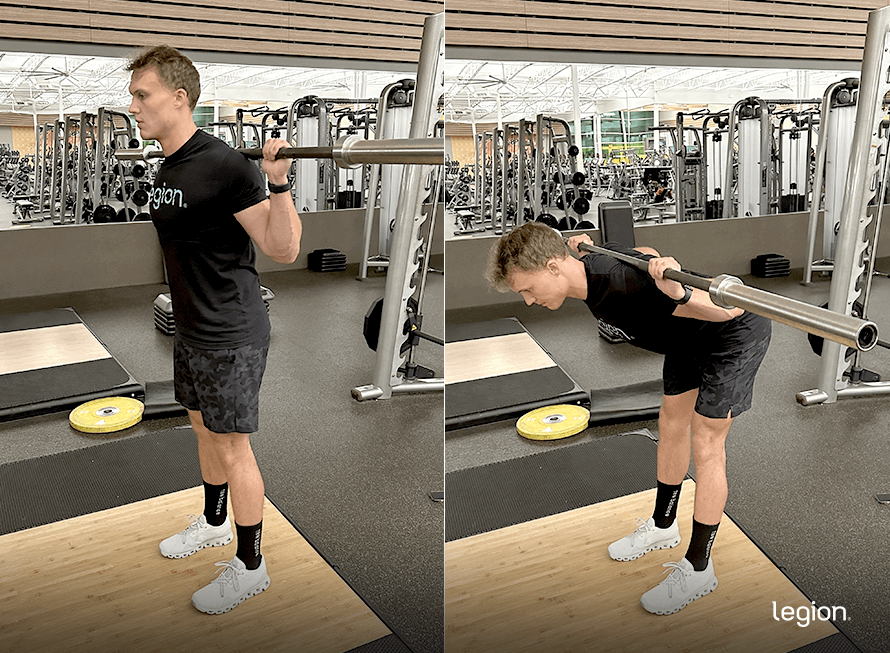
Why: Many people think of the good morning as a leg exercise, but research shows it’s about as effective at training your lower back as exercises like the clean, snatch, Romanian deadlift, and row.
How to: Adjust the hooks in a squat rack so the bar is at mid-chest height. Get under the bar and position it across your mid-traps and rear delts so it rests right above the little ridges on the back of your shoulder blades. Grip the bar with an overhand grip (palms facing away from you), then unrack the bar, take 1-to-2 steps backward, and position your feet about shoulder-width apart. With slightly bent knees, move your butt backward so your torso can “hinge” forward and lower the bar in a straight line toward the ground. Once you can’t lower the bar any further without bending your back, reverse the movement and return to the starting position.
Sets and Reps: 3 sets of 4-to-6 reps with 2-to-3 min rest
7. Pull-up
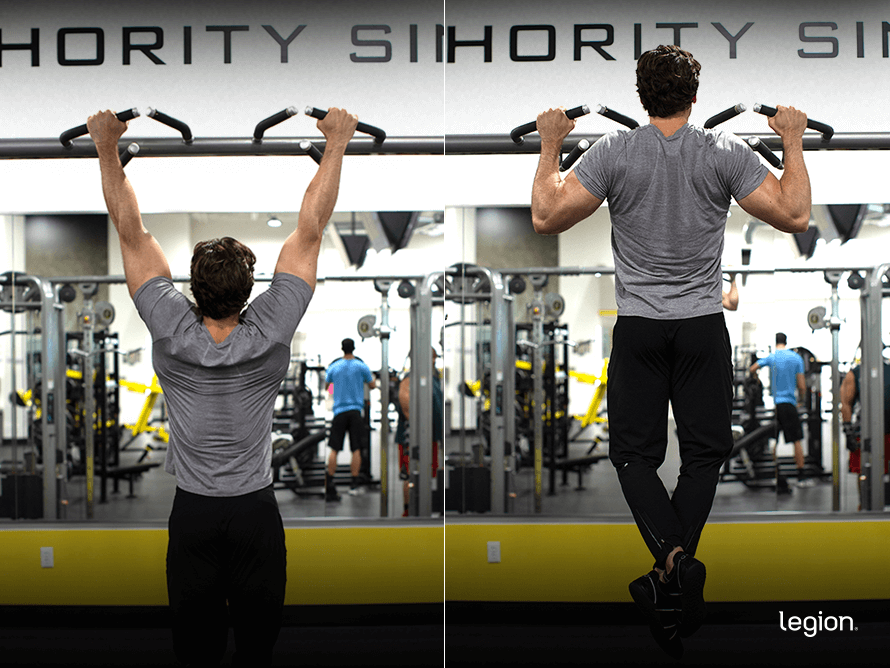
Why: The pull-up trains almost all the muscles of the back, but it’s a particularly good back exercise for training your lats. It also trains your biceps, abs, and even your chest muscles to a lesser extent.
How to: Grip a pull-up bar with your palms facing away from you and slightly wider than shoulder-width apart, then lift your feet so you’re hanging with your arms extended. Pull your body upward until your chin rises above your hands, then lower yourself to the starting position.
Sets and Reps: 3 sets of 4-to-6 reps with 2-to-3 min rest
8. Chin-up
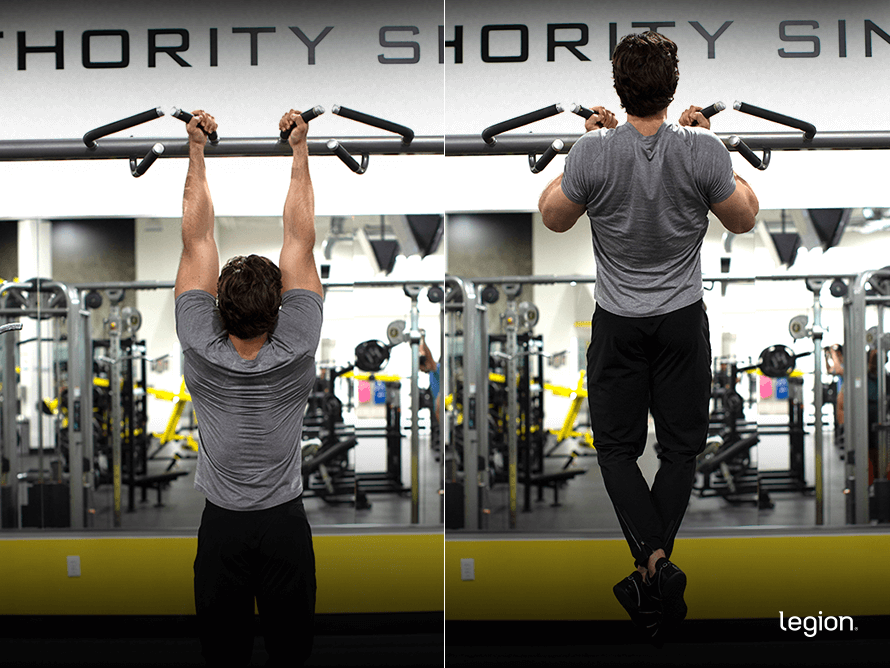
Why: The chin-up trains your back about as well as the pull-up. The difference is the chin-up emphasizes your biceps, whereas the pull-up trains your lower traps slightly more.
How to: Grip a pull-up bar with your palms facing toward you and shoulder-width apart, then lift your feet so that you’re hanging with your arms extended. Pull your body upward until your chin rises above your hands, and then lower yourself and return to the starting position.
Sets and Reps: 3 sets of 4-to-6 reps with 2-to-3 min rest
9. Barbell Bent-Over Row
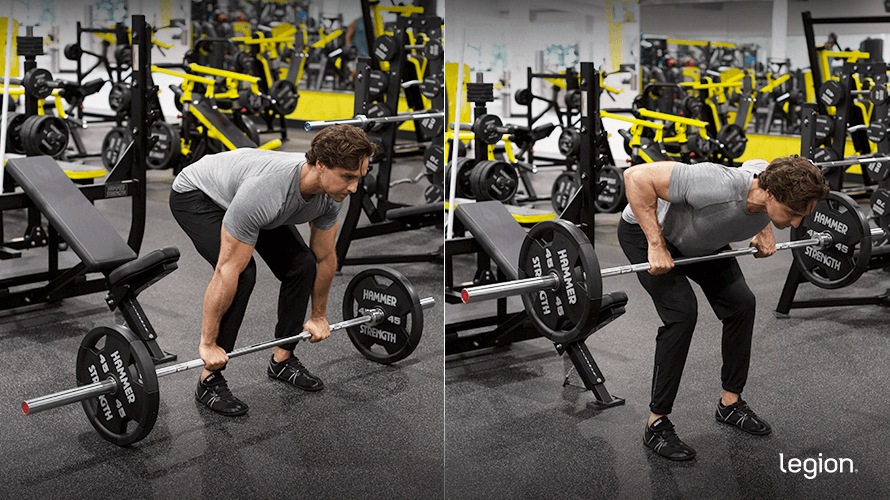
Why: Like most barbell back exercises, the barbell bent-over row allows you to lift heavy weights safely, which makes it ideal for gaining muscle and strength in your entire back.
How to: Position your feet shoulder-width apart under a loaded barbell with your toes pointed slightly outward. Bend over and grab the bar with a slightly wider than shoulder-width grip and with your palms facing you. Straighten your back and raise your hips until your back is roughly parallel to the floor. Drive through your legs, then, using the momentum generated by your lower body, squeeze your shoulder blades together and pull the weight to your upper body, touching it anywhere between your lower chest and belly button. Reverse the movement and return to the starting position.
Sets and Reps: 3 sets of 4-to-6 reps with 2-to-3 min rest
10. Single-Arm Dumbbell Row
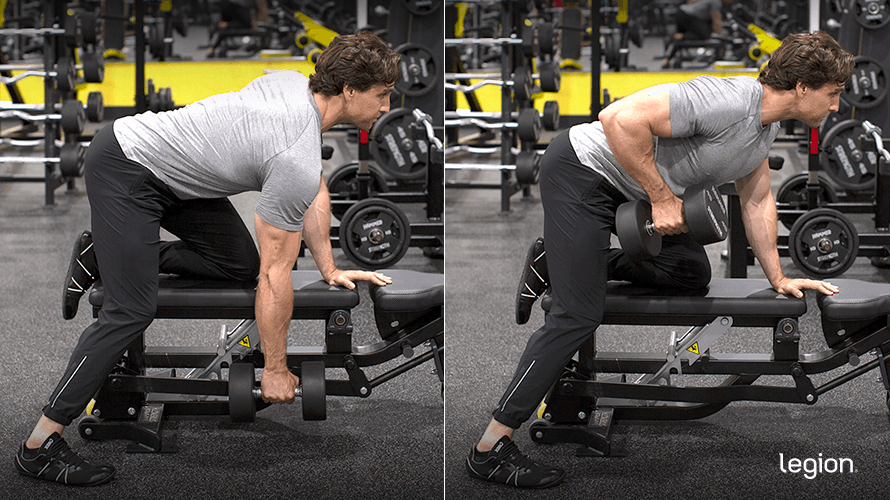
Why: The single-arm dumbbell row allows you to train each side of your back independently, which helps you find and fix muscle imbalances.
How to: Hold a dumbbell in your right hand. Plant your left knee and hand firmly on a bench, your right foot on the floor a foot or two from the bench, and let your right arm hang straight toward the floor. Keeping your back straight, pull the weight upward until it touches your torso, and then return the dumbbell to the starting position. Once you’ve completed the desired number of reps, repeat the process with your left arm.
Sets and Reps: 3 sets of 4-to-6 reps with 2-to-3 min rest
11. Chest-Supported Row
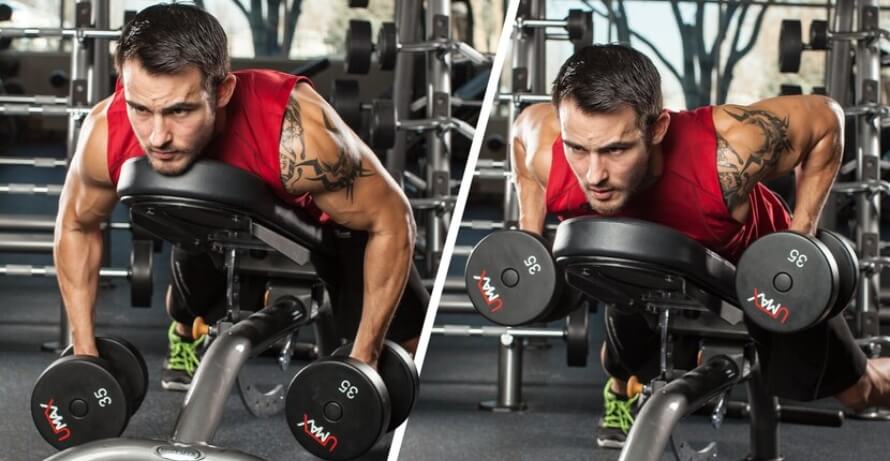
Why: The chest-supported row prevents you from using momentum to “cheat” the weight up, which means your back and arm muscles do all the work.
How to: Set an incline bench to roughly a 30-degree angle. Grab a dumbbell in each hand and lie prone on the bench with your feet on the floor and your arms extended toward the ground. Pull the dumbbells upward until they’re by your sides, then reverse the movement and return to the starting position.
Sets and Reps: 3 sets of 4-to-6 reps with 2-to-3 min rest
12. Lat Pulldown
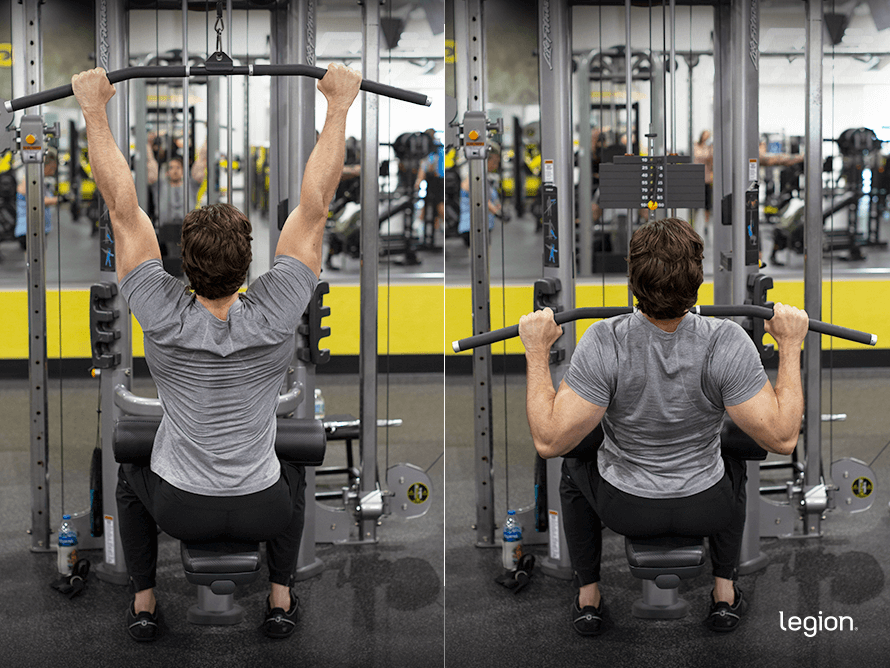
Why: The lat pulldown is an excellent exercise for training your lats, biceps, and traps, especially for beginners who struggle to do chin-ups and pull-ups.
How to: Adjust the thigh pad of a lat pulldown machine so that it locks your lower body in place, then stand up and grab the bar with an overhand grip (palms facing away from you). While keeping your grip on the bar and your arms straight, sit down, allowing your body weight to pull the bar down with you. Nudge your thighs under the thigh pads and plant your feet on the floor. Pull the bar toward your chest. Once the bar is underneath your chin, reverse the movement and return to the starting position.
Sets and Reps: 3 sets of 4-to-6 reps with 2-to-3 min rest
13. Seated Cable Row
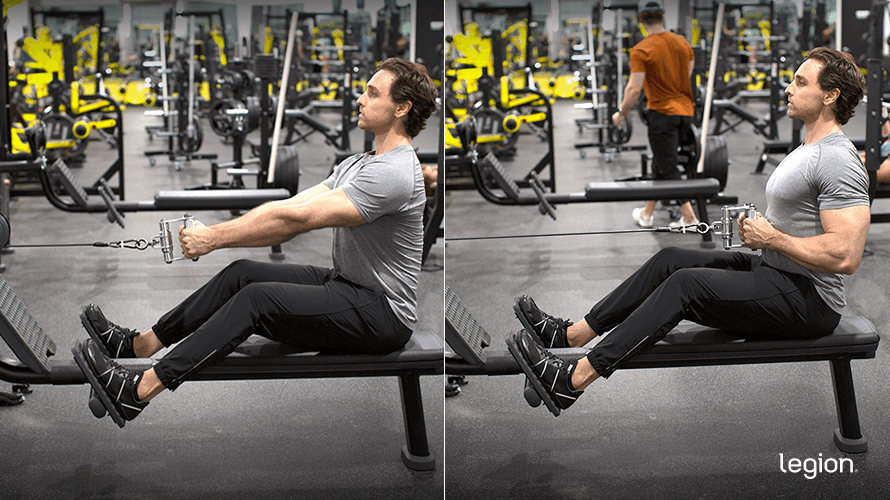
Why: The seated cable row is a highly effective cable back exercise that keeps constant tension on your back muscles throughout each rep, taxing your back slightly differently from free-weight exercises.
How to: Sit on the cable row machine and place your feet on the footrest while maintaining slightly bent knees. Lean forward and grab the handle with a neutral grip (palms facing each other), then lean back with your arms extended in front of you. Straighten your back and pull the handle toward your stomach. Once your hands touch your torso, reverse the movement and return to the starting position.
Sets and Reps: 3 sets of 4-to-6 reps with 2-to-3 min rest
14. T-Bar Row
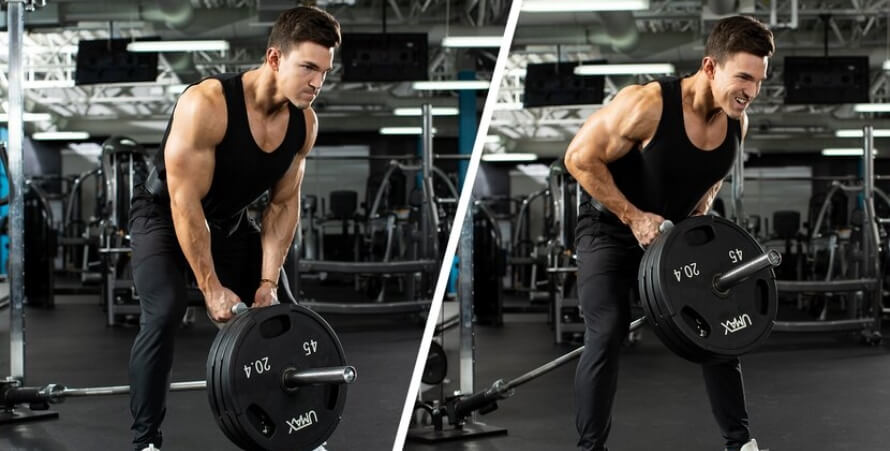
Why: Like all compound back exercises, the T-bar row enables you to lift a lot of weight safely. Since you use a neutral grip (palms facing each other), it also trains the muscle groups in your back slightly differently than other barbell row variations.
How to: Place one end of an empty barbell in the corner of a room or rack or into a landmine attachment, and load the other with weight plates. Straddle the barbell and hook a close-grip attachment from a cable pulley machine under the weighted end of the barbell. Grab hold of the handles with a neutral grip (palms facing each other), straighten your back, and slightly straighten your legs so you’re supporting the weight. Pull the bar toward your chest until the weight plate touches your body, then reverse the movement and return to the starting position.
Sets and Reps: 3 sets of 4-to-6 reps with 2-to-3 min rest
15. Seal Row
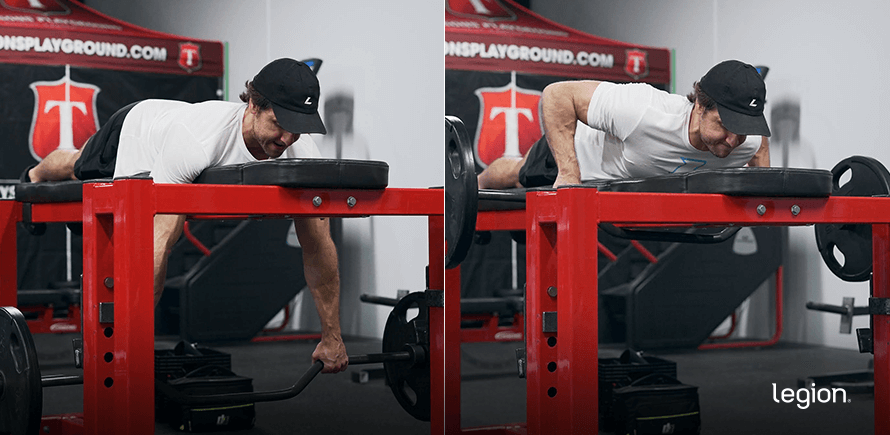
Why: Because you lie prone on a bench during the seal row, you can’t generate momentum with your lower body. This forces your back muscles to do most of the work and ensures you stimulate them sufficiently.
How to: Place a loaded barbell under a seal row bench, then lie prone on the bench. Grab the bar with a slightly wider than shoulder-width grip and your palms facing toward your feet. Pull the barbell toward your upper body until it touches the underside of the bench. Reverse the movement and return to the starting position.
Sets and Reps: 3 sets of 4-to-6 reps with 2-to-3 min rest
16. Machine Row
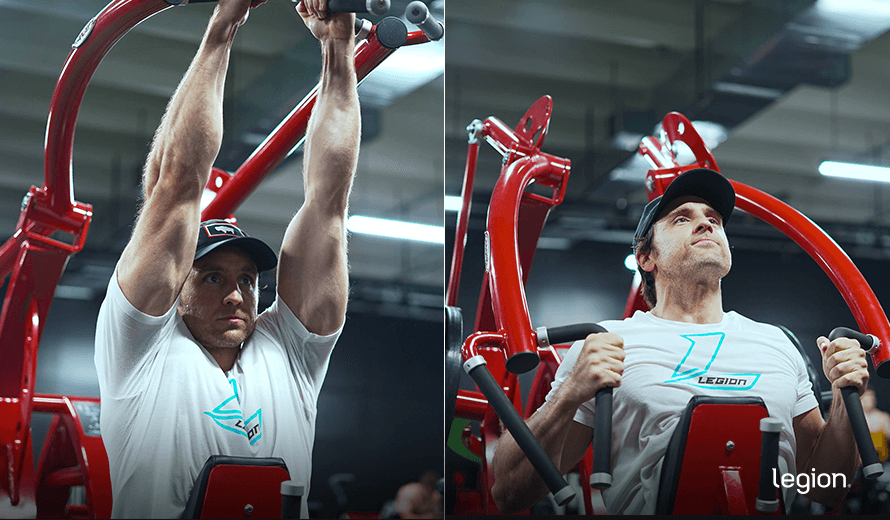
Why: The machine row is a great alternative to free-weight rowing exercises for beginners because it requires less coordination and balance, is more straightforward to learn, and requires less setup.
How to: Sit on the row machine seat with your chest against the chest pad. Lean forward and grab the handles with a neutral or overhand grip (palms facing each other or downward). Pull the handles toward your body until your hands are by your sides. Reverse the movement and return to the starting position.
Sets and Reps: 3 sets of 4-to-6 reps with 2-to-3 min rest
17. Meadows Row
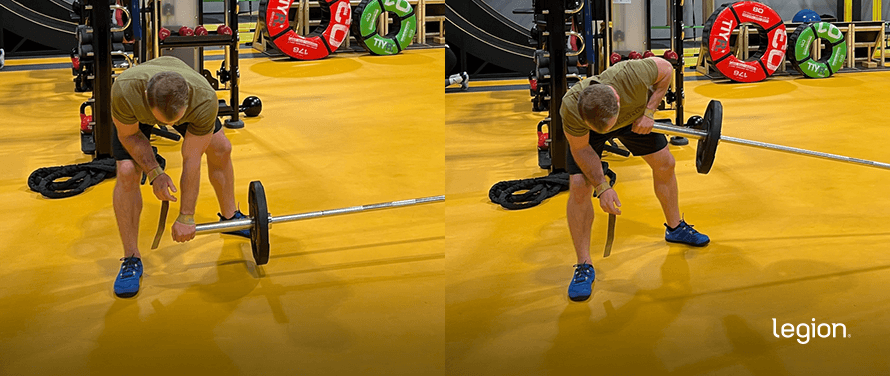
Why: Because you anchor the barbell at one end in the Meadows row, it trains your back through a slightly different range of motion than other exercises. Training your muscles in different positions and through different ranges of motions is beneficial because it produces more balanced and complete muscle growth than training with less variation.
How to: Wedge one end of a barbell into the corner of the room or insert it into a landmine attachment and load the other with weight. Position your right foot perpendicular to the weighted end of the barbell and your left foot 2-to-3 feet behind your right. Bend over at the waist until your back is almost parallel with the floor, and grab the end of the barbell with your left hand. Pull the weight until your hand touches your torso, then lower it to the starting position. Once you’ve completed the desired number of reps, repeat on your right side.
Sets and Reps: 3 sets of 4-to-6 reps with 2-to-3 min rest
18. Cable Pullover
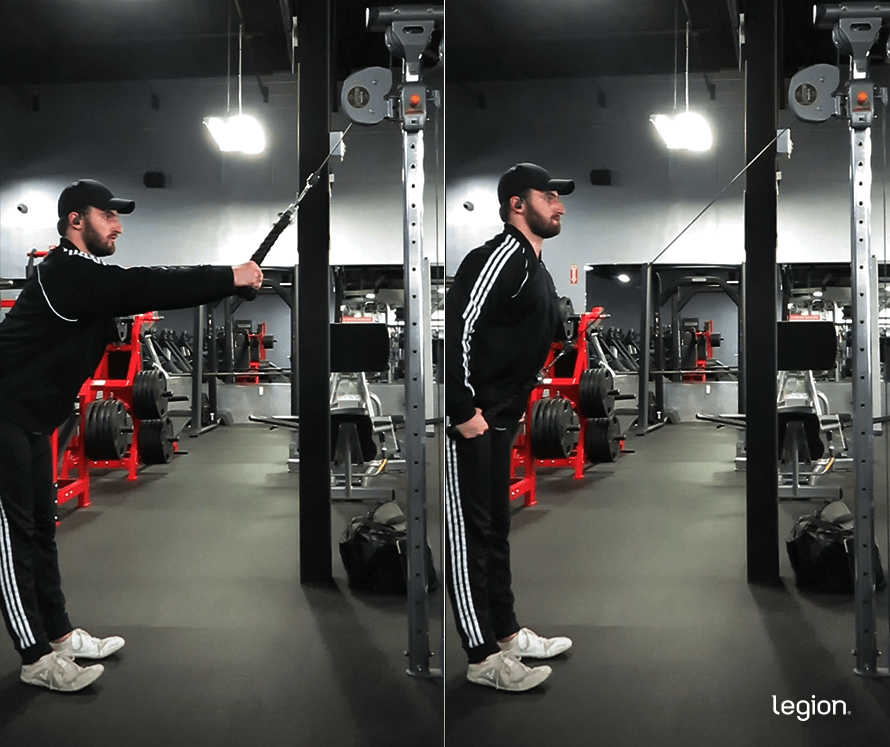
Why: The cable pullover trains your lats in a fully stretched position and through a long range of motion, which aids muscle growth.
How to: Set the pulley to the highest position on a cable machine and attach the rope handle. Hold one end of the rope in each hand, and step away from the pulley until you feel tension in the cable. Lean forward until your body makes a 45-degree angle with the floor and your arms are nearly straight overhead. Set your feet shoulder-width apart and bend your knees a little, then with a small bend in your elbows, pull the rope in an arc toward your feet until your hands are by your thighs or a little past them. Reverse the movement and return to the starting position.
Sets and Reps: 3 sets of 6-to-8 reps with 2-to-3 min rest
19. Dumbbell Pullover
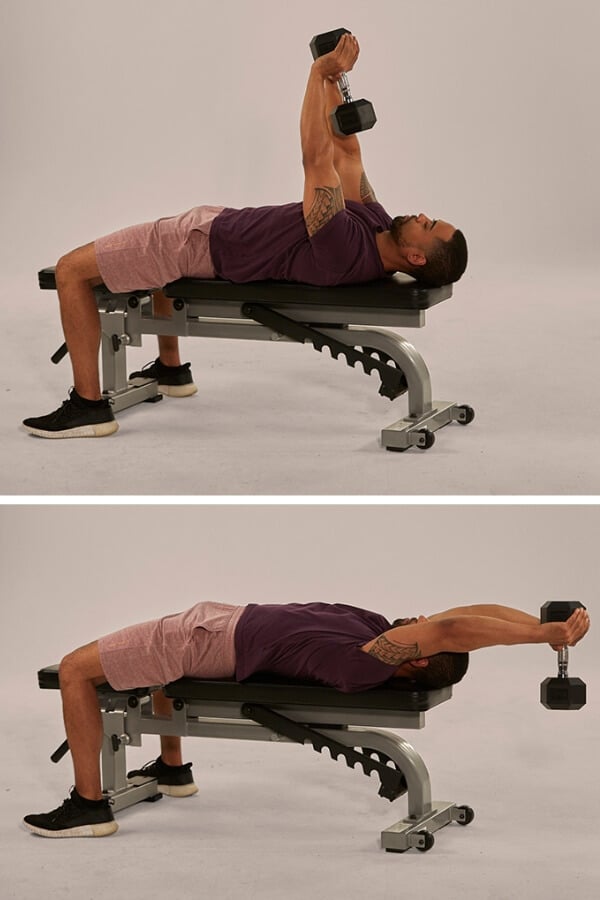
Why: The dumbbell pullover is a good alternative to the cable pullover if you don’t have access to a cable machine (if you train at home or while traveling, for example).
How to: While lying on a flat bench with your feet on the floor, hold a dumbbell at one end with both hands and rest it on your chest. Position your head is as close to the end of the bench as possible. Press the dumbbell over your chest until your elbows are almost completely locked. While maintaining a slight bend in your elbows, lower the dumbbell in an arc over your head until your biceps are next to your ears, then reverse the movement and return to the starting position.
Sets and Reps: 3 sets of 6-to-8 reps with 2-to-3 min rest
20. Inverted Row
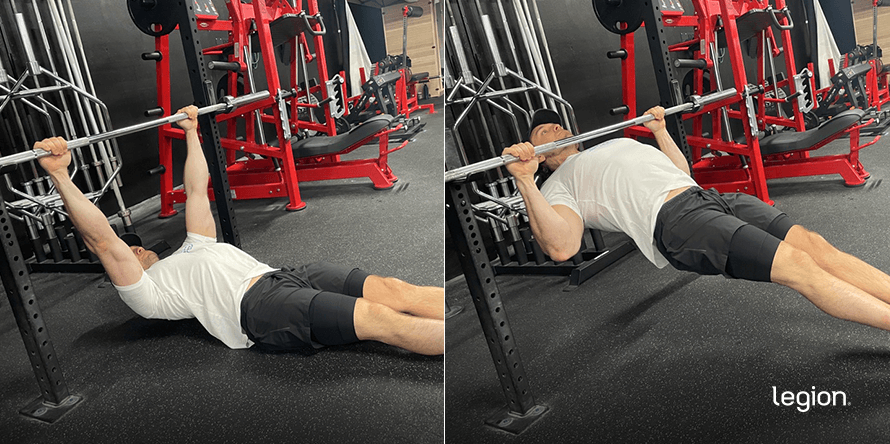
Why: The inverted row is a good back exercise for new weightlifters because it allows you to build strength slowly, which helps prepare your body for more challenging row variations.
How to: Place a barbell in a rack so it’s slightly more than arm’s length off the floor. Lie on the floor under the bar, grab the bar with a slightly wider than shoulder-width grip with your palms facing toward your feet and your arms straight. Rest your heels on the floor and straighten your legs and back. Keeping your back and legs straight and your butt high, pull your chest upward until it touches the bar, then lower yourself to the starting position.
Sets and Reps: 3 sets of 10-to-20 reps with 2-to-3 min rest
21. Dumbbell Rear Lateral Raise
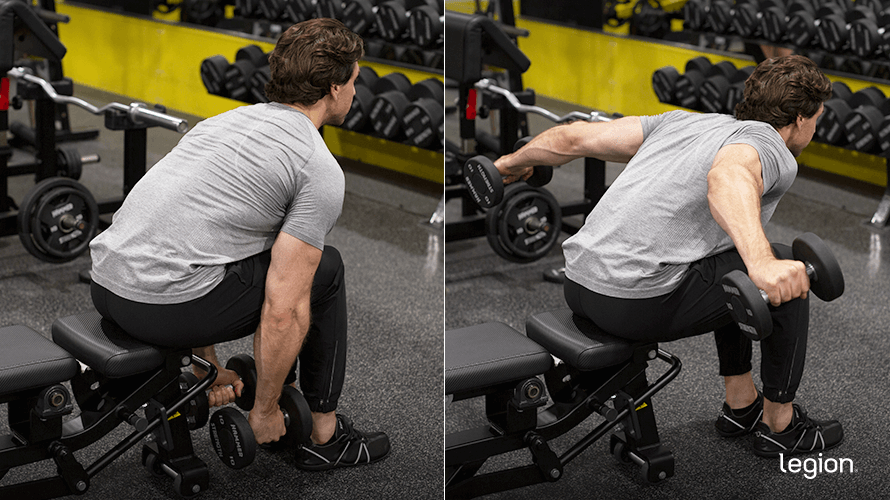
Why: The dumbbell rear lateral raise is a great exercise for training all the muscles in your upper back, especially your rear delts and traps.
How to: Whether standing or seated, bend at the hips so that your upper body is as close to parallel to the floor as possible. Hold a dumbbell in each hand, and while keeping your back flat, lift the dumbbells out to the side until your upper arm is parallel to the floor. Reverse the movement and return to the starting position.
Sets and Reps: 3 sets of 6-to-8 reps with 2-to-3 min rest
22. Barbell Rear Delt Row
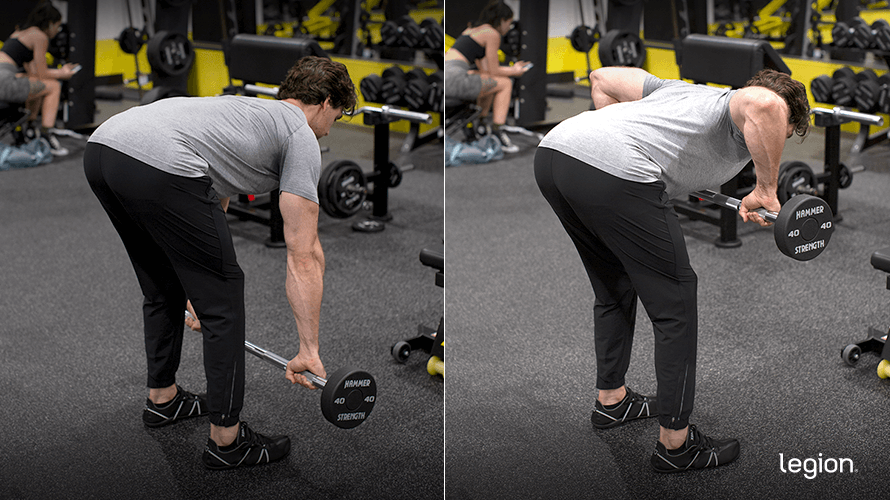
Why: The barbell rear delt row is similar to the barbell row except that you pull the weight to your mid-chest instead of your stomach. This reduces the amount your lats contribute to the exercise and makes it more taxing on your upper back and rear delts.
How to: Position your feet under a loaded barbell about shoulder-width apart with your toes pointed slightly outward. Bend over and grab the bar with a slightly wider than shoulder-width grip and with your palms facing you. Flatten your back so it’s roughly parallel to the floor, and let your arms hang straight down. Pull the barbell to your mid-chest, flaring your elbows at about a 60-degree angle relative to your body. Once the bar touches your body, reverse the movement and return to the starting position.
Sets and Reps: 3 sets of 6-to-8 reps with 2-to-3 min rest
23. Upright Row
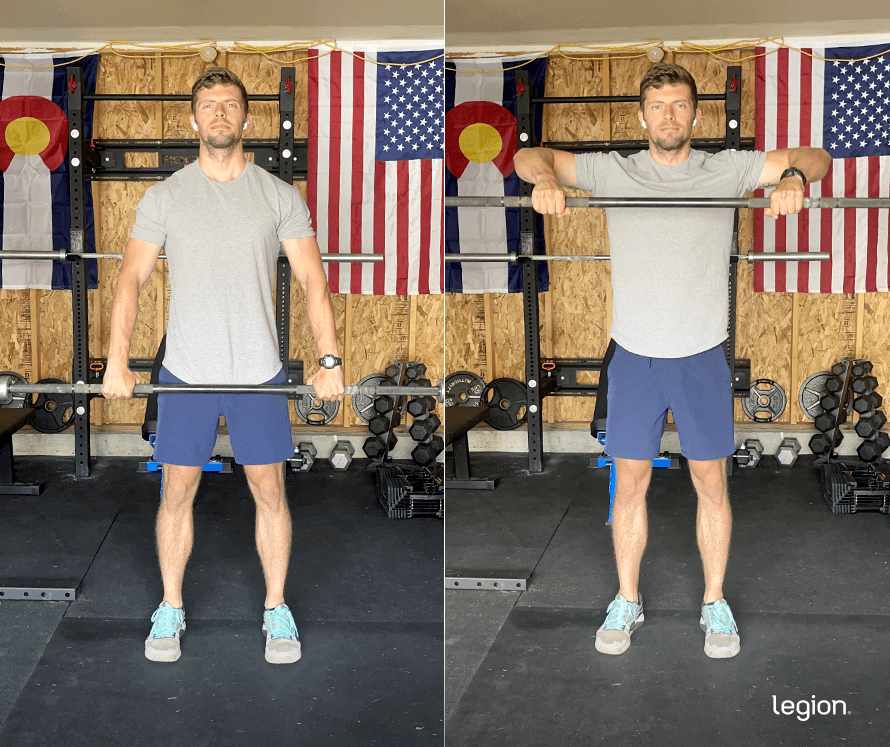
Why: The upright row is a fantastic exercise for training your upper back muscles, especially your rear delts and traps.
How to: Stand upright and hold a barbell in front of your thighs with your palms facing you. Lift the bar straight upward until your upper arms are parallel with the floor, keeping your elbows higher than your forearms throughout the movement. Reverse the movement and return to the starting position.
Sets and Reps: 3 sets of 6-to-8 reps with 2-to-3 min rest
24. Banded Row
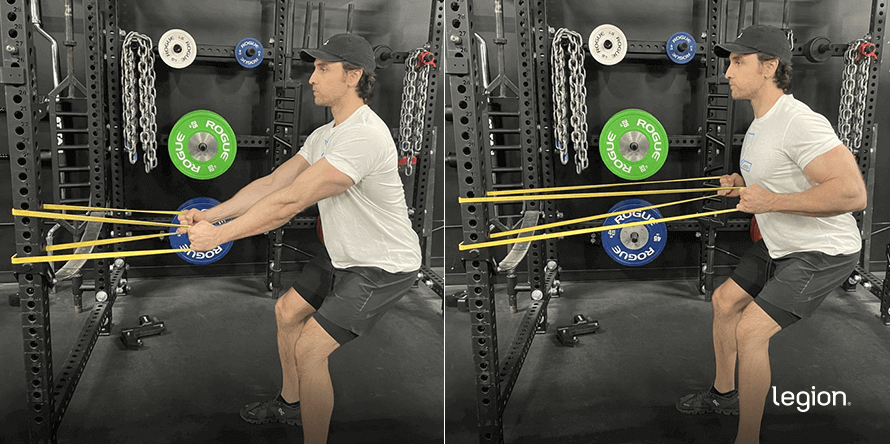
Why: The banded row is a good back exercise for people who train at home or while traveling and have limited space and equipment. However, because a resistance band offers almost no resistance when it’s slack, there’s little tension on your back muscles when stretched, making it slightly less effective than other rowing exercises on this list.
How to: Wrap a resistance band around a sturdy post at about the height of your belly button. Hold one end of the band in each hand and walk backward, allowing your arms to straighten until all the slack is out of the band. Plant your feet about shoulder-width apart and bend your knees slightly. Keeping your back straight, pull both hands toward your torso until they’re by your sides, then reverse the movement and return to the starting position.
Sets and Reps: 3 sets of 10-to-20 reps with 2-to-3 min rest
25. Banded Lat Pulldown
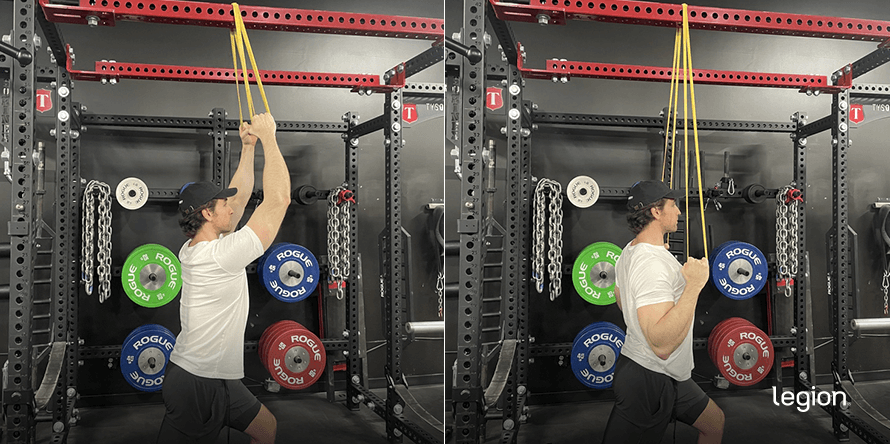
Why: The banded lat pulldown is an effective compound back exercise if you don’t have access to a gym. That said, it places no tension on your back muscles when they’re stretched, making it less effective than other similar exercises, such as the pull-up, chin-up, or lat pulldown.
How to: Wrap a resistance band around a pull-up bar or some other point several feet above your head. Hold one end of the band in each hand and walk backward, allowing your arms to straighten until all the slack is out of the band. Pull both ends of the band straight down until your hands are below your chin. Reverse the movement and return to the starting position.
Sets and Reps: 3 sets of 10-to-20 reps with 2-to-3 min rest
Supplements to Maximize Your Back Gains
If you want to accelerate your back gains, consider these three supplements:
- Protein powder: Protein powder, such as Whey+ (Legion’s whey isolate) or Casein+ (Legion’s micellar casein), provides your body with the nutrients needed to build muscle tissue and recover from workouts.
- Creatine: Creatine boosts muscle and strength gain, improves anaerobic endurance, and reduces muscle damage and soreness from your workouts. For a natural source of creatine, try Legion’s creatine monohydrate, creatine gummies, or post-workout Recharge.
- Pre-workout: A high-quality pre-workout enhances energy, mood, and focus, increases strength and endurance, and reduces fatigue. For a top-tier pre-workout containing clinically effective doses of 6 science-backed ingredients, try Legion’s Pulse with caffeine or without.
(If you’d like even more specific advice about which supplements you should take to reach your health and fitness goals, take the Legion Supplement Finder Quiz, and in less than a minute, you’ll know exactly what supplements are right for you.)
Scientific References +
- Lake, Jason, et al. “Effect of a Hexagonal Barbell on the Mechanical Demand of Deadlift Performance.” Sports, vol. 5, no. 4, 24 Oct. 2017, p. 82, https://doi.org/10.3390/sports5040082.
- Burnett, Angus, et al. “BACK STRESS and ASSISTANCE EXERCISES in WEIGHTLIFTING.” ISBS - Conference Proceedings Archive, 2002, ojs.ub.uni-konstanz.de/cpa/article/view/723. Accessed 18 Mar. 2021.
- Dickie, James A. , et al. Electromyographic Analysis of Muscle Activation during Pull-up Variations. Nov. 2016, https://doi.org/10.1016/j.jelekin.2016.11.004.
- Youdas, James W, et al. “Surface Electromyographic Activation Patterns and Elbow Joint Motion during a Pull-Up, Chin-Up, or Perfect-PullupTM Rotational Exercise.” Journal of Strength and Conditioning Research, vol. 24, no. 12, Dec. 2010, pp. 3404–3414, https://doi.org/10.1519/jsc.0b013e3181f1598c. Accessed 9 Aug. 2019.
- Fenwick, Chad M J, et al. “Comparison of Different Rowing Exercises: Trunk Muscle Activation and Lumbar Spine Motion, Load, and Stiffness.” Journal of Strength and Conditioning Research, vol. 23, no. 2, Mar. 2009, pp. 350–358, https://doi.org/10.1519/jsc.0b013e3181942019. Accessed 6 Mar. 2020.
- Ronai, Peter. “The Barbell Row Exercise.” ACSMʼs Health & Fitness Journal, vol. 21, no. 2, 2017, pp. 25–28, https://doi.org/10.1249/fit.0000000000000278. Accessed 7 June 2020.
- Doma, Kenji, et al. “Kinematic and Electromyographic Comparisons between Chin-Ups and Lat-Pull down Exercises.” Sports Biomechanics, vol. 12, no. 3, Sept. 2013, pp. 302–313, https://doi.org/10.1080/14763141.2012.760204.
- Handa, Tohru , et al. Comparative Electromyographical Investigation of the Biceps Brachii, Latissimus Dorsi, and Trapezius Muscles during Five Pull Exercises. Apr. 2005, https://doi.org/10.7600/jspfsm.54.159.
- Costa, Bruna Daniella de Vasconcelos, et al. “Does Performing Different Resistance Exercises for the Same Muscle Group Induce Non-Homogeneous Hypertrophy?” International Journal of Sports Medicine, vol. 42, no. 09, 13 Jan. 2021, pp. 803–811, https://doi.org/10.1055/a-1308-3674.
- Park, Se-yeon, and Won-gyu Yoo. “Differential Activation of Parts of the Latissimus Dorsi with Various Isometric Shoulder Exercises.” Journal of Electromyography and Kinesiology, vol. 24, no. 2, Apr. 2014, pp. 253–257, https://doi.org/10.1016/j.jelekin.2013.12.004. Accessed 9 Aug. 2019.
- Gerling, Michael E., and Stephen H. M. Brown. “Architectural Analysis and Predicted Functional Capability of the Human Latissimus Dorsi Muscle.” Journal of Anatomy, vol. 223, no. 2, 13 June 2013, pp. 112–122, https://doi.org/10.1111/joa.12074. Accessed 25 Apr. 2022.
- Schoenfeld, Brad J, and Jozo Grgic. “Effects of Range of Motion on Muscle Development during Resistance Training Interventions: A Systematic Review.” SAGE Open Medicine, vol. 8, no. 8, Jan. 2020, p. 205031212090155, https://doi.org/10.1177/2050312120901559.
- McAllister, Matthew J., et al. “Effect of Grip Width on Electromyographic Activity during the Upright Row.” The Journal of Strength & Conditioning Research, vol. 27, no. 1, 1 Jan. 2013, pp. 181–187, journals.lww.com/nsca-jscr/Fulltext/2013/01000/Effect_of_Grip_Width_on_Electromyographic_Activity.25.aspx, https://doi.org/10.1519/JSC.0b013e31824f23ad.










